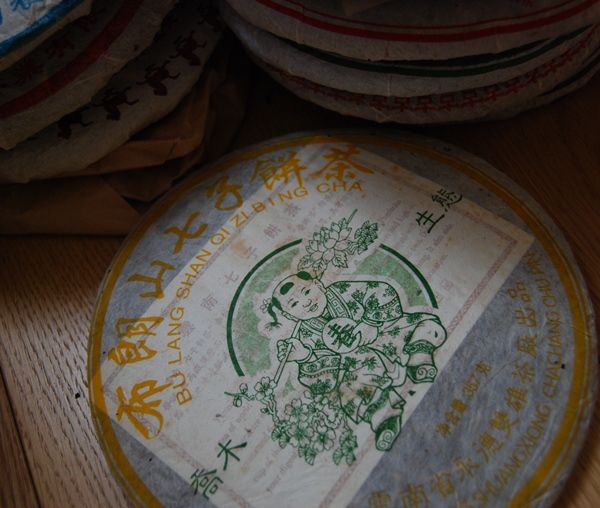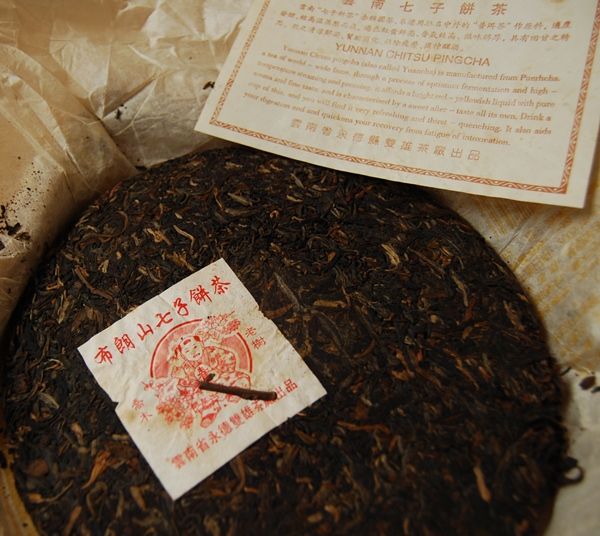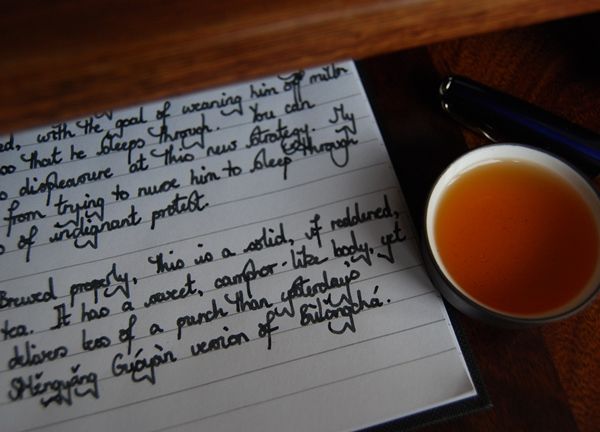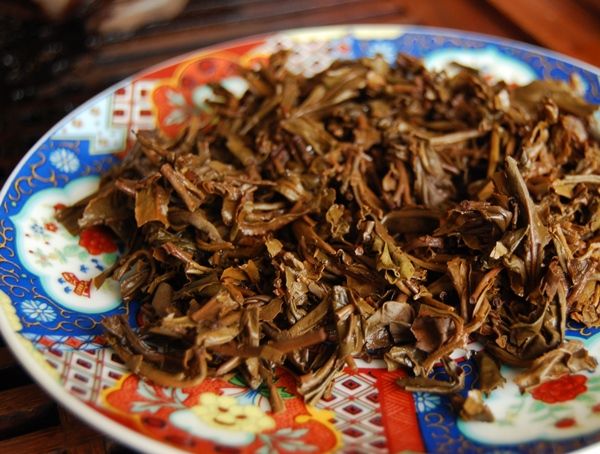"What on earth is Shuangxiong?" I hear you ask. How does one even begin to pronounce it, let alone drink it?
I have encountered only one example from this producer before, and it (the 2003 Jinzhen Gongpu) was generously provided by our Singaporean chum, Keng, who was kind enough to buy a tong on our behalf, if memory serves me correctly. It was a lovely cake, featured in the Chinese version of the Art of Tea (whose typographical setting is no more accomplished than the English version, you'll be relieved to learn).
As the little chap on the wrapper suggests, this is a Bulang-region cake - I understand that he is wearing Bulangzu [Bulang ethnic minority] costume.
The full name of the producer is "Yunnansheng Yongde Shuangxiong Chachang", where Yongde is way out in Lincang prefecture, far north from the usual tea regions. The company specialises in tea from that area, unsurprisingly, but this particular cake comes, of course, from a more orthodox area. [Shuangxiong, approximately "schwang-schyong", means "double hero", I think.]
It currently sells for 175 RMB on the mighty Taobaowang, but one should search using the traditional characters for "shuangxiong" in order to find the correct cake. (As ever, the more enthusiastic reader is invited to refer to the ever-majestic Babelcarp for assistance.)
Psst, Lew: any chance of a Babelcarp app for Android? Your loyal usership pleads with you!
The compression is reasonably tight, and I struggle to liberate a portion of leaves from the bing without breaking them. Even before my clumsy hands commit them to destruction, the leaves seem to be large fragments of medium-to-large leaves. Some seem a touch red; the majority are healthily dark. Happily, some of the tips have already adopted the rusty orange colour of maturity.
I firmly believe that you could buy almost any cake (within reason), give it six years of storage in humid Singapore, and it will come out tasting pretty darned delicious.
Brewed properly (i.e., avoiding overbrewing due to leaf breakage and compression), this is a solid, if reddened, tea. It has a sweet, camphor-like body, yet delivers less of a punch than some other Bulang-area cakes.
Unlike the 2003 Shuangxiong, I probably won't pursue this to the point of buying more cakes. However, the cake that we do have, courtesy of Keng's generosity, is a great example of solid Singaporean storage going to work on a tea that was perhaps a little more mainstream when it started out its life.
You can't argue with chunky camphor flavours, which do a great deal for making this cake more than it otherwise would be.






I'm pretty sure the kid is wearing traditional Chinese clothing, rather than Bulang area clothes.
ReplyDeleteAlso -- why do you say "if reddened" as if it's a fault? This tea is now 6 years old. I'll be nervous if it's still green.
Dear MarshalN,
ReplyDeleteI hope you're enjoying Hong Kong - are you teaching out there?
Regular readers may recall that my use of the phrase "reddened", as a verb, is my short-hand for referring to cakes that have been processed in an interesting manner to redden their leaves a little, perhaps achieved via preoxidation. While this cake is aged (and aged in Singapore), it is significantly "redder" than its peers of the same age and background, kindly provided by Keng. It has a character that strongly suggests such "reddening" to me: a reduction in complexity and potency, the presence of malt flavours - the range of usual indicators of early processing. This is a common trend for the cakes and samples I've tried from Shuangxiong - they seem quite happy to "redden" their leaves, perhaps to make their tea more accessible. I'm sure you know the type.
All the best,
Hobbes
Psst, Lew: any chance of a Babelcarp app for Android? Your loyal usership pleads with you!
ReplyDeleteYou mean, a full-fledged app with its own copy of the database? Sorry, not for Android and not for iWhatever. I don’t have the time and energy to write more versions of the application while trying to keep the database up-to-date and live my life. Besides, the database inside any copy of a mobile device app would be increasingly obsolete.
If you mean that the Babelcarp web app looks or behaves badly in your Android device’s browser, please send me screenshots and whatever other evidence seems germane. I’ve recently made changes to make the Carp more useful on mobile devices, but I don’t have anything running Android to try it on.
By the way, thanks for acting on Babelcarp’s new URL!
Dear Hobbes,
ReplyDeleteI understand what you mean by reddened, but I do not believe it is possible to tell whether or not a particular cake has been tempered with 6 years ago when it has been stored in a hot and humid environment. What your picture shows, assuming it's accurate, is quite within the range of possible (dry) storage outcome for a cake of this age. Just because some other cakes have aged less doesn't mean anything about this particular cake in question.
In general I find it quite difficult to say with any amount of confidence whether or not some cake's processing was off, especially after a few years of storage. The reduction of complexity and potency as well as the presence of malt flavours are entirely normal for something that is six years old. This is especially true of many Lincang teas, although by no means exclusively so. I'm sure as a scientist you well understand that when there are enough uncontrolled variables present, assigning the cause of a change to one thing is a pretty risky proposition.
Dear Lew,
ReplyDeleteBabelcarp is one of my most used web-sites! Regarding an app, they're typically just mobile-designed GUIs, which interrogate a remote server for their content. For example, my most-used apps are the Economist, BBC News, and Google+, and they are, effectively, just useful GUIs for the usual on-line content. Using a web browser on a mobile is just fiddly, that's all - hence the popularity of the apps that I listed, and their ilk. If there are no plans for an app, fiddling with a mobile browser is a small price to pay for use of such a valuable resource as is The Carp.
Dear MarshalN,
I think we may differ on the point of being able to say if a cake has been "reddened" / processed after some years, where the difference is in the "some"!
Certainly, if one winds the clock along far enough, it becomes impossible to tell if a cake is processed strangely. After twenty years, is this cake's lack of performance due to initial processing, or due to its subsequent storage? Therefore, asymptotically, I agree with you.
However, on more local length-scales (say, 3-5 years), from watching the growth of my own known-to-be-processed cakes, it's fairly clear that the characteristics they exhibited at birth are still detectable, to varying degrees, after that interval. This Shuangxiong shares these characteristics, and so I have a reasonably high confidence that it's of the same genre. It would be interesting to take the "Pepsi challenge" with 5-year-old cakes for which the "reddened" / "not reddened" labels are known in order to determine our classification accuracy. I suspect that it would be more than the 0.5 that one would otherwise obtain by chance.
(The used leaves are a bimodal mixture of red and green, in this case, which reduces uncertainty!)
All the best,
Hobbes
Dear Hobbes,
ReplyDeleteI understand your point, but at the same time, can't agree with it entirely. One of the things that makes me worry a bit when I see you talk about "reddened" tea is the frequency of this charge. While it does happen once in a while, I find it to be much, much rarer than you seem to encounter this phenomenon. This is why I wonder if, sometimes, it's actually the aging trajectory that you're observing here with some of the teas (such as the abovementioned Lincang) which tend to also fall into the less potent/complexity and malty camp. There are multiple paths to mediocrity in tea, and I don't think they all go through the "reddened" gate.
Dear MarshalN,
ReplyDeleteThanks for the continued interesting discussion.
Of course, you're quite right that there are many roads to Rome (excepting the fact that all roads lead there anyway!).
However, a very significant proportion of the cakes that I sample are brazenly "reddened". Really, there is no mistaking it, when it occurs in cakes that are 1-3 years old, and I would say that the majority of cakes that I sample are in that age range - I try them young! It also tends to occur in precisely those cakes in which you think it would: the blends, the plantation material, the lesser cakes. They're striving to be something that they're not, and attempting to achieve through (I would say fairly unambiguous) processing. It seems quite predictable.
Conversely, in the upper-echelon cakes that I try, such processing is almost absent: the single-mountain cakes from reliable sources, the hand-made cakes, the good and traditional output from the big factories. There, everything is raw, and absent the features that would lead me to classify something as "reddened".
"Reddening" definitely (in my experience) clusters around the bottom end of the tea market. As I wrote before, I've watched them age (no doubt as have you), and they share characteristics with, for example, this Shuangxiong that are entirely and noticeably separable from the cakes of the upper echelon that have undergone similar storage (either by me, or by colleagues).
Maybe I'm just unlucky, or maybe I drink more from the bottom half of the pu'ercha league-table than do you, but I come across this "reddening" quite a lot, and it's usually a homogenising influence across most regions - and a predictable one!
You mentioned Lincang cakes in particular, but (much to my chagrin), I don't have a huge amount of Lincang, despite it being one of my favourites. Those that I do have tend to be split between "reddened" / "not reddened" according to the quality of the cake, however.
(I should also add that while Shuangxiong is a Lincang-based outfit, these leaves are from Bulangshan, of course.)
All the best,
Hobbes
Dear Hobbes,
ReplyDeleteI generally take mountain claims with quite a bit of salt - I think very often they say one thing and give you another, especially with some of these smaller factories in the wild west days of pu.
That said, I wonder if what you're tasting is just bad tea - bad plantation, or what not, rather than deliberate processing. Processing, after all, takes work, and to make something look like what it is not is a skill, however, nefarious. I don't think many of these smaller factories had such skills.
I'm going to be very interested in the Menghai Yesheng '98 review, since I'm pretty sure that one is reddened, and profitably so, despite the loss of power.
ReplyDelete--shah8
That 1998 Menghai is really very delicious - the humid Hong Kong storage has been very kind to it. Almost too kind, as you will see!
ReplyDeleteToodlepip,
Hobbes